新编汉英翻译教程(第二版)课时PPT
合集下载
《新编英汉翻译教程》PPT课件
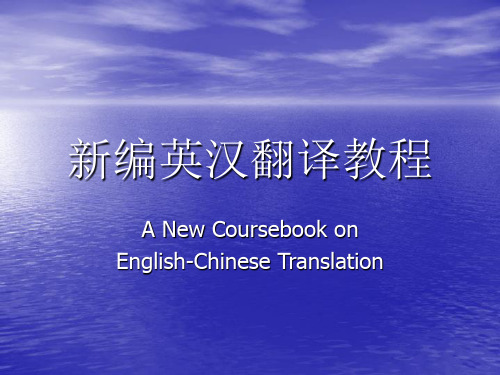
The building workers said that they must work diligently and painstakingly, with great ambition and lofty aspiration, for 300 days, in order to complete the construction task of the expressway within this year.
The only concession he made to the climate was to wear a white dinner jacket.
译文1:他对气候的唯一让步就是穿 了一件白色的短餐衣。
译文2: 气候变化,他仅稍稍作了一 点变通,赴宴时穿了件白色的短礼服。
If certain animal psychologists are right, a dog adopts his family in a most literal way -- taking it for granted that the family is the
译文1:在他母亲去世36年之后,海 明威又想起了那次历险奇遇,并试图 写一部小说。
译文2: 大约36年过后,在他母亲去 世后的不久海明威又想起了那次遭遇 的险情,并试图就此写一部小说。
外语腔是初学翻译者不知不觉地 会在汉语译文中表现出来的一种不当 倾向。翻译时所要表达的内容来自外 语原文,原文的词语和结构形式随着 内容一起进入到我们的大脑,于是原 文的语言形式被带入译文,造成了译 文的外语腔。
译文2: 我发现音乐史上有三类作曲家, 他们各自的音乐创作方式有所不同。
The traditionalist type of composer begins with a pattern rather than with a theme. The creative act with Palestrina is not the thematic conception so much as the personal treatment of a well-established
The only concession he made to the climate was to wear a white dinner jacket.
译文1:他对气候的唯一让步就是穿 了一件白色的短餐衣。
译文2: 气候变化,他仅稍稍作了一 点变通,赴宴时穿了件白色的短礼服。
If certain animal psychologists are right, a dog adopts his family in a most literal way -- taking it for granted that the family is the
译文1:在他母亲去世36年之后,海 明威又想起了那次历险奇遇,并试图 写一部小说。
译文2: 大约36年过后,在他母亲去 世后的不久海明威又想起了那次遭遇 的险情,并试图就此写一部小说。
外语腔是初学翻译者不知不觉地 会在汉语译文中表现出来的一种不当 倾向。翻译时所要表达的内容来自外 语原文,原文的词语和结构形式随着 内容一起进入到我们的大脑,于是原 文的语言形式被带入译文,造成了译 文的外语腔。
译文2: 我发现音乐史上有三类作曲家, 他们各自的音乐创作方式有所不同。
The traditionalist type of composer begins with a pattern rather than with a theme. The creative act with Palestrina is not the thematic conception so much as the personal treatment of a well-established
新英汉翻译课件教程 chapter 2 翻译的过程43页PPT

谢谢!
新英汉翻译课件教程 chapter 2 翻译的 过程
1、合法而稳定的权力在使用得当时很 少遇到 抵抗。 ——塞 ·约翰 逊 2、权力会使人渐渐失去温厚善良的美 德。— —伯克
3、最大限度地行使权力总是令人反感 ;权力 不易确 定之处 始终存 在着危 险。— —塞·约翰逊 4、权力会奴化一切。——塔西佗
5、虽然权力是一头固执的熊,可是金 子可以 拉着它是奢侈 。——CocoCha nel 62、少而好学,如日出之阳;壮而好学 ,如日 中之光 ;志而 好学, 如炳烛 之光。 ——刘 向 63、三军可夺帅也,匹夫不可夺志也。 ——孔 丘 64、人生就是学校。在那里,与其说好 的教师 是幸福 ,不如 说好的 教师是 不幸。 ——海 贝尔 65、接受挑战,就可以享受胜利的喜悦 。——杰纳勒 尔·乔治·S·巴顿
新编汉英翻译教程(第二版)课时PPT
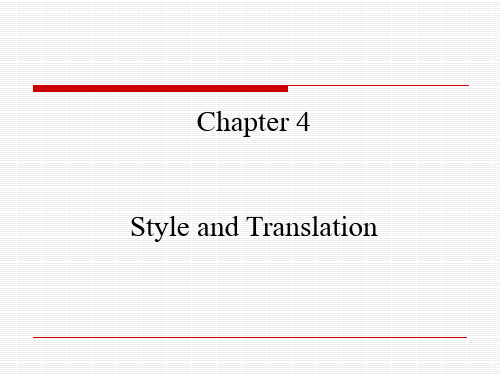
1. What is style?
Theodore Savory: Style is the essential characteristic of every piece of writing, the outcome of the writer’s personality and his emotions at the moment, and no single paragraph can be put together without revealing in some degree the nature of its author.
4 Lexical Level of Stylistic Devices Interaction of Dictionary and Contextual Meanings; Interaction of Primary and Derivative Meanings; Interaction of Logical and Emotive Meanings; Intensification of a Certain Feature of a Thing or Phenomenon
两份请帖,一份是比较正式的,用语也比 较严谨。而另一份则是比较随意的,用语 亲切而不拘礼。 1) Will you please honor me by coming to my humble home for a simple meal this FRIDAY evening? We will be very pleased if you can come at 6 o’clock. 2) Frank, we’d like you and your wife to come over for dinner this Friday evening. Six-thirty at our place. Can you make it.
《新编英汉翻译教程》课件

意译
侧重于传达原文的意义和精神, 不拘泥于原文的句式和表达方式 ,进行适当的调整和改写。
增词法与减词法
增词法
整、流畅。
减词法
在翻译过程中,删除原文中一些不必 要的词汇或短语,使译文更加简洁、 明了。
词序调整与语态转换
词序调整
句法对比
总结词
句法翻译技巧
详细描述
在进行英汉翻译时,需要掌握一定的句法翻译技巧。例如,可以采用拆句、合并、调整语序等方法, 使译文更加符合汉语表达习惯。同时,需要注意句子的逻辑关系和语义连贯性,避免出现断句或语义 不明的情况。
篇章对比
总结词
篇章结构差异
详细描述
英语和汉语在篇章结构方面存在较大差异。英语中篇章结构 较为严谨,常用主题句和段落来组织文章。而汉语中篇章结 构则较为灵活,常通过语义和语境来组织文章。
新闻翻译
总结词
注重时效性和信息传递
详细描述
新闻翻译要求快速、准确地传递信息,确保译 文能够及时地呈现新闻事件的最新进展。
总结词
关注新闻价值和语言风格
详细描述
新闻翻译需要关注新闻价值和语言风格,确保译文 具有新闻的客观性、准确性和可读性。
总结词
了解新闻行业规范和惯例
详细描述
新闻翻译需要了解新闻行业规范和惯例,以确保译文符 合新闻报道的规则和要求。
根据中文的语法和表达习惯,调整原 文中的词序,使译文更加符合中文的 表达方式。
语态转换
将原文中的被动语态转换为中文的主 动语态,或将原文中的主动语态转换 为中文的被动语态,以使译文更加自 然、流畅。
PART 04
翻译实践
文学翻译
总结词
注重语言艺术和审美体验
01
侧重于传达原文的意义和精神, 不拘泥于原文的句式和表达方式 ,进行适当的调整和改写。
增词法与减词法
增词法
整、流畅。
减词法
在翻译过程中,删除原文中一些不必 要的词汇或短语,使译文更加简洁、 明了。
词序调整与语态转换
词序调整
句法对比
总结词
句法翻译技巧
详细描述
在进行英汉翻译时,需要掌握一定的句法翻译技巧。例如,可以采用拆句、合并、调整语序等方法, 使译文更加符合汉语表达习惯。同时,需要注意句子的逻辑关系和语义连贯性,避免出现断句或语义 不明的情况。
篇章对比
总结词
篇章结构差异
详细描述
英语和汉语在篇章结构方面存在较大差异。英语中篇章结构 较为严谨,常用主题句和段落来组织文章。而汉语中篇章结 构则较为灵活,常通过语义和语境来组织文章。
新闻翻译
总结词
注重时效性和信息传递
详细描述
新闻翻译要求快速、准确地传递信息,确保译 文能够及时地呈现新闻事件的最新进展。
总结词
关注新闻价值和语言风格
详细描述
新闻翻译需要关注新闻价值和语言风格,确保译文 具有新闻的客观性、准确性和可读性。
总结词
了解新闻行业规范和惯例
详细描述
新闻翻译需要了解新闻行业规范和惯例,以确保译文符 合新闻报道的规则和要求。
根据中文的语法和表达习惯,调整原 文中的词序,使译文更加符合中文的 表达方式。
语态转换
将原文中的被动语态转换为中文的主 动语态,或将原文中的主动语态转换 为中文的被动语态,以使译文更加自 然、流畅。
PART 04
翻译实践
文学翻译
总结词
注重语言艺术和审美体验
01
《汉英翻译教程》课件

02
汉英翻译技巧
词汇选择与翻译
总结词
准确传达原文意义
详细描述
选择适当的词汇进行翻译,确保准确传达原文的含义和语气。了解词 汇的准确含义和用法,包括一词多义和语境意义。
总结词
符合英语表达习惯
详细描述
在翻译过程中,选用符合英语表达习惯的词汇,避免生硬直译,使译 文更加自然流畅。
句式转换与翻译
总结词 详细描述
05
汉英翻译发展趋势与展望
人工智能在汉英翻译中的应用
机器翻译
利用人工智能技术,实现汉英自动翻译,提高 翻译效率。
自然语言处理
通过分析自然语言文本,提取语义信息,辅助 人工翻译。
神经网络翻译
利用深度学习技术,提高翻译的准确性和流畅性。
跨文化交际背景下的汉英翻译
文化差异
关注汉英文化差异,理解文化内涵,避免文化冲突。
总结词
注意文化差异和思维方式
详细描述
由于文化和思维方式的差异,汉英翻译时需要注意这些 差异,避免因文化冲突或思维方式不同而引起的误解或 不满。
04
汉英翻译常见问题与对策
词汇理解与表达问题
总结词
词汇是翻译的基础,理解词汇含义并准确表达是汉英翻译的关键。
详细描述
在汉英翻译过程中,译者可能遇到对词汇理解不准确或表达不地道的问题。例如,某些词汇在汉语中有丰富的文 化内涵,但在英语中可能没有完全对应的表达,导致词汇的语义信息丢失。
《汉英翻译教程》课 件
xx年xx月xx日
• 汉英翻译概述 • 汉英翻译技巧 • 汉英翻译实践 • 汉英翻译常见问题与对策 • 汉英翻译发展趋势与展望 • 课后练习与参考答案
目录
01
汉英翻译概述
新编汉英翻译教程(第二版)课时PPT

毛主席《为女民兵题照》 毛主席《为女民兵题照》
Most Chinese daughters have a desire strong; To face powder and not to powder the face.
高天滚滚寒流急; 高天滚滚寒流急; 大地微微暖气吹。 大地微微暖气吹。
毛主席《冬云》 毛主席《冬云》
严复
《天演论》 天演论》 公派到英国留学, 公派到英国留学,先入 普茨毛斯大学, 普茨毛斯大学,后转到 格林威治海军学院 译文简练,首倡“ 译文简练,首倡“信、 达、雅”的译文标准 1912年严复受袁世凯命 年严复受袁世凯命 担任北大校长之职
In translation, there are three difficulties to overcome, namely, faithfulness, expressiveness and elegance. It is already very difficult to achieve faithfulness. Without expressiveness, mere faithfulness would mean work to no avail.
那么这个想法怎么会由一个不起眼的念 头变成了文字,然后又变成了电影呢? 头变成了文字,然后又变成了电影呢? 答案是名人精疲力尽了。 答案是名人精疲力尽了。这位点石成金 的好莱坞宠儿由《西雅图夜未眠》 的好莱坞宠儿由《西雅图夜未眠》到 《玩具故事》和《阿波罗13号》,获得 玩具故事》 阿波罗 号 了一连串的票房成功,并因《 了一连串的票房成功,并因《费城的故 和随后的《阿甘正传》 事》和随后的《阿甘正传》连续两年问 鼎奥斯卡奖。 鼎奥斯卡奖。
Among average respectable woman envy plays an extraordinary large part. If you are sitting in the underground and a welldressed woman happens to walk along the car, watch the eyes of the other women. You will see that every one of them, with the possible exception of those who are even better dressed, will watch the woman with malevolent glances, and will be struggling to draw inferences as derogatory to her.
Most Chinese daughters have a desire strong; To face powder and not to powder the face.
高天滚滚寒流急; 高天滚滚寒流急; 大地微微暖气吹。 大地微微暖气吹。
毛主席《冬云》 毛主席《冬云》
严复
《天演论》 天演论》 公派到英国留学, 公派到英国留学,先入 普茨毛斯大学, 普茨毛斯大学,后转到 格林威治海军学院 译文简练,首倡“ 译文简练,首倡“信、 达、雅”的译文标准 1912年严复受袁世凯命 年严复受袁世凯命 担任北大校长之职
In translation, there are three difficulties to overcome, namely, faithfulness, expressiveness and elegance. It is already very difficult to achieve faithfulness. Without expressiveness, mere faithfulness would mean work to no avail.
那么这个想法怎么会由一个不起眼的念 头变成了文字,然后又变成了电影呢? 头变成了文字,然后又变成了电影呢? 答案是名人精疲力尽了。 答案是名人精疲力尽了。这位点石成金 的好莱坞宠儿由《西雅图夜未眠》 的好莱坞宠儿由《西雅图夜未眠》到 《玩具故事》和《阿波罗13号》,获得 玩具故事》 阿波罗 号 了一连串的票房成功,并因《 了一连串的票房成功,并因《费城的故 和随后的《阿甘正传》 事》和随后的《阿甘正传》连续两年问 鼎奥斯卡奖。 鼎奥斯卡奖。
Among average respectable woman envy plays an extraordinary large part. If you are sitting in the underground and a welldressed woman happens to walk along the car, watch the eyes of the other women. You will see that every one of them, with the possible exception of those who are even better dressed, will watch the woman with malevolent glances, and will be struggling to draw inferences as derogatory to her.
汉英翻译教程_课件_U2

二、中国时政文献翻译策略
使用被动语态 具体语境下,可考虑将原文隐含主语句的宾语或相关内容调整为译文的主
语,形成被动语态,突出原文语义重点。 例. 党的十八大以来,➊我们坚持导向为魂、移动为先、内容为王、创新
为要,➋在体制机制、政策措施、流程管理、人才技术等方面加快融合步伐, ➌建立融合传播矩阵,➍打造融合产品,➎取得了积极成效。
二、中国时政文献翻译策略
• 人才强国战略 the strategy on developing a quality workforce • 建设制造强国 to build China into a manufacturer of quality • 加快建设人才强国 to step up efforts to make China a talent-strong country • 推进体育强国建设 to build China into a country strong in sport • 实现农业大国向农业强国跨越 to transform China from a country with high agricultural output to one with a leading edge in agriculture
• 爱国统一战线 patriotic united front • 社会主义核心价值观 the core socialist values • 中国特色社会主义 socialism with Chinese characteristics
二、中国时政文献翻译策略
中国时政文献经常借助隐喻修辞或生活化语言表达具体语义,语言风格 独特,语义鲜明,在具体语境下可考虑保留原文词语的语言特色,形象传达 原文思想内容,也可以归为对应式翻译策略。
《汉英翻译教程》课件

语篇翻译与处理
总结词
注意语篇连贯性与衔接
详细描述
语篇的连贯性与衔接是评价译文质量的重要标准之一。在汉英翻译过程中,应特别关注语篇的逻辑关系和信息组 织方式。合理使用过渡词、短语或从句等衔接手段,确保译文在整体上流畅自然、逻辑严密。同时,要注意避免 出现信息重复或遗漏现象,确保语篇信息的完整性。
03
和准确。
文化差异处理不当的问题与对策
要点一
总结词
要点二
详细描述
汉英翻译中存在较大的文化差异,处理不当会导致译文出 现歧义或误解。
在进行汉英翻译时,译者应充分了解中英文化背景和表达 习惯的差异,采取适当的策略处理文化差异。对于一些具 有特定文化含义的词汇或表达方式,译者可以通过直译、 意译、音译等不同的翻译方法进行处理。同时,译者还需 要在译文中添加必要的注释或解释,以帮助读者更好地理 解译文的文化背景和含义。
总结词
注重语言修辞和表达技巧的运用
详细描述
广告文案的汉英翻译需要注重语言修辞和表达技巧的运 用,运用修辞手法和语言技巧,提高译文的吸引力和感 染力。
04
汉英翻译案例分析
文学作品的汉英翻译案例分析
总结词
忠实传达原作思想、语言风格和意境
详细描述
通过对经典文学作品如《红楼梦》、《水浒传》等的汉 英翻译案例进行深入分析,探讨如何准确传达原作的思 想、语言风格和意境,以及如何处理文化差异和语言特 色。
科技文章的汉英翻译
总结词
注重专业术语和知识的准确性
VS
详细描述
科技文章的汉英翻译需要注重专业术语和 知识的准确性,准确传达原文的专业含义 和技术细节,确保译文内容科学、严谨。
科技文章的汉英翻译
总结词
新编汉英翻译教程(第二版)课时PPT

(ii) social context: the objective environment in which the addresser produces and the addressee interprets an utterance, such as settings for communication, the status of and the relationship between the addresser and addressee, their social and backgrounds; (iii) cognitive environment: any experiences, background knowledge or other which contribute to communication and cognition(何 自然, 1997:210).
Restrictive function is one of the major functions of context and also playing an important part in meaning understanding. I never had much in seeing you. There was no love lost between us at any time, I think. 我向来不大看到你,咱们两人之间大 概什么时候都不曾有过好感。
So writers today should take heart. We could dress like Lady Gaga and hang from a cage at a Yankees game — if any of us looked as good near-naked, that is. 所以今天的作家应该鼓足勇气。 只要我们 中任何人有几分姿色,我们就可以打扮成 嘎嘎夫人那样,在洋基队比赛中将自己挂 在笼子状的裙子里---几近裸体。
新编英汉翻译教程 ppt
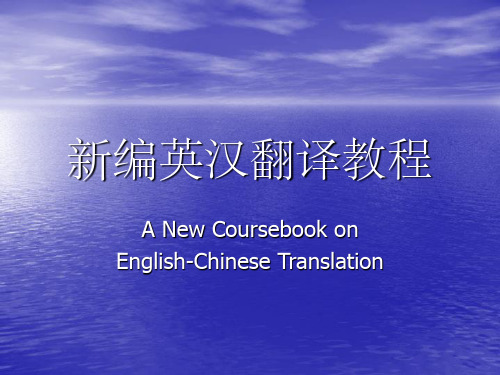
发现自我,如实地表现自我,你自然会为人 们所喜欢——为那些尊重你的真正个性的人 们所喜欢。
Where do you expect Shanghai to be in five years?
你预计今后五年上海的发展目 标如何?
Public opinion plays a vital and healthy role in the political realm.
译文1:公共舆论在政治领域起着生 命力的、健康的作用。
译文2: 舆论在政治领域起着极其重 要的、有益的作用。
什么是好的n?
翻译的两类问题:一类是译文语
义基本符合原文,但汉语表达有欠正 确;另一类是汉语表达尚有可读性, 但译文语义不符原文。
目前翻译界普遍接受的,也是作 为一般翻译学习者必须努力掌握的标 准,简而言之是两条:忠实 (Faithfulness) 和流畅 (Smoothness)。
新编英汉翻译教程
A New Coursebook on English-Chinese Translation
严复:信 达 雅
Faithfulness, fidelity, truthfulness Smoothness, expressiveness Elegancy
德国译学教授 Wolfram Wilss 在 The Science of Translation:Problems & Methods一书中说: Translation is not simply a matter of seeking other words with similar meaning, but of finding appropriate ways of saying things in another language. Translating is always meaning-based, i.e. it is the transfer of meaning instead
Where do you expect Shanghai to be in five years?
你预计今后五年上海的发展目 标如何?
Public opinion plays a vital and healthy role in the political realm.
译文1:公共舆论在政治领域起着生 命力的、健康的作用。
译文2: 舆论在政治领域起着极其重 要的、有益的作用。
什么是好的n?
翻译的两类问题:一类是译文语
义基本符合原文,但汉语表达有欠正 确;另一类是汉语表达尚有可读性, 但译文语义不符原文。
目前翻译界普遍接受的,也是作 为一般翻译学习者必须努力掌握的标 准,简而言之是两条:忠实 (Faithfulness) 和流畅 (Smoothness)。
新编英汉翻译教程
A New Coursebook on English-Chinese Translation
严复:信 达 雅
Faithfulness, fidelity, truthfulness Smoothness, expressiveness Elegancy
德国译学教授 Wolfram Wilss 在 The Science of Translation:Problems & Methods一书中说: Translation is not simply a matter of seeking other words with similar meaning, but of finding appropriate ways of saying things in another language. Translating is always meaning-based, i.e. it is the transfer of meaning instead
英汉互译简明教程(第二版)课件14 第四篇 专有名词的翻译

3. 机构名称的翻译 3.1 音译
世界著名企业名称和品牌通常都有约定俗成的译法,其 中很多采用的是音译,如: • Nike 耐克 • Michelin 米其林 • Cadillac 凯迪拉克 • Phillips 飞利浦 • Maxwell 麦斯威尔
专有名词英译汉
3. 机构名称的翻译 3.2 意译
• 如:中国北京清华大学28号楼502室,应翻译为Room 502, Dormitory Building 28, Tsinghua University, Beijing, China。
• 中文地址翻译成英文的顺序是:X室、X号、X路/街、X区 /县、X市、X省,然后是中国。
3.中文地址的英译
其汉英对照如下:
1. 汉语地名的翻译方法
汉语地名翻译通常采用汉语拼音加直译的方法。 1.1 一般专名加通名构成汉语地名的翻译
这类情况通常将专名译作汉语拼音,然后再意译通名,例如: • 珠海市 Zhuhai City • 王府井商业街 Wangfujing Shopping Mall • 青藏高原 the Qinghai-Tibet Plateau • 四川盆地 the Sichuan Basin • 京杭运河 the Beijing-Hangzhou Canal
香山 Xiangshan Hill, 象鼻山 the Elephant Hill • Peak (山峰)
莲花峰 the Lotus Peak, 独秀峰 the Singular Beauty Peak
1. 汉语地名的翻译方法
1.5 通名为不同汉字的同一种译法 与前面相反,不同的汉字在很多情况下可英译为同一个单 词。譬如“江、河、水、溪”都统一英译为river,如:
• 长江 the Yangtze River • 黄河 the Yellow River • 珠江 the Pearl River • 古田溪 the Gutian River
世界著名企业名称和品牌通常都有约定俗成的译法,其 中很多采用的是音译,如: • Nike 耐克 • Michelin 米其林 • Cadillac 凯迪拉克 • Phillips 飞利浦 • Maxwell 麦斯威尔
专有名词英译汉
3. 机构名称的翻译 3.2 意译
• 如:中国北京清华大学28号楼502室,应翻译为Room 502, Dormitory Building 28, Tsinghua University, Beijing, China。
• 中文地址翻译成英文的顺序是:X室、X号、X路/街、X区 /县、X市、X省,然后是中国。
3.中文地址的英译
其汉英对照如下:
1. 汉语地名的翻译方法
汉语地名翻译通常采用汉语拼音加直译的方法。 1.1 一般专名加通名构成汉语地名的翻译
这类情况通常将专名译作汉语拼音,然后再意译通名,例如: • 珠海市 Zhuhai City • 王府井商业街 Wangfujing Shopping Mall • 青藏高原 the Qinghai-Tibet Plateau • 四川盆地 the Sichuan Basin • 京杭运河 the Beijing-Hangzhou Canal
香山 Xiangshan Hill, 象鼻山 the Elephant Hill • Peak (山峰)
莲花峰 the Lotus Peak, 独秀峰 the Singular Beauty Peak
1. 汉语地名的翻译方法
1.5 通名为不同汉字的同一种译法 与前面相反,不同的汉字在很多情况下可英译为同一个单 词。譬如“江、河、水、溪”都统一英译为river,如:
• 长江 the Yangtze River • 黄河 the Yellow River • 珠江 the Pearl River • 古田溪 the Gutian River
新编英汉翻译教程+++118页PPT

新编英汉翻译教程+++
6
、露凝无游 Nhomakorabea氛
,
天
高
风
景
澈
。
7、翩翩新 来燕,双双入我庐 ,先巢故尚在,相 将还旧居。
8
、
吁
嗟
身
后
名
,
于
我
若
浮
烟
。
9、 陶渊 明( 约 365年 —427年 ),字 元亮, (又 一说名 潜,字 渊明 )号五 柳先生 ,私 谥“靖 节”, 东晋 末期南 朝宋初 期诗 人、文 学家、 辞赋 家、散
文 家 。汉 族 ,东 晋 浔阳 柴桑 人 (今 江西 九江 ) 。曾 做过 几 年小 官, 后辞 官 回家 ,从 此 隐居 ,田 园生 活 是陶 渊明 诗 的主 要题 材, 相 关作 品有 《饮 酒 》 、 《 归 园 田 居 》 、 《 桃花 源 记 》 、 《 五 柳先 生 传 》 、 《 归 去来 兮 辞 》 等 。
1
0
、
倚
南
窗
以
寄
傲
,
审
容
膝
之
易
安
。
66、节制使快乐增加并使享受加强。 ——德 谟克利 特 67、今天应做的事没有做,明天再早也 是耽误 了。——裴斯 泰洛齐 68、决定一个人的一生,以及整个命运 的,只 是一瞬 之间。 ——歌 德 69、懒人无法享受休息之乐。——拉布 克 70、浪费时间是一桩大罪过。——卢梭
6
、露凝无游 Nhomakorabea氛
,
天
高
风
景
澈
。
7、翩翩新 来燕,双双入我庐 ,先巢故尚在,相 将还旧居。
8
、
吁
嗟
身
后
名
,
于
我
若
浮
烟
。
9、 陶渊 明( 约 365年 —427年 ),字 元亮, (又 一说名 潜,字 渊明 )号五 柳先生 ,私 谥“靖 节”, 东晋 末期南 朝宋初 期诗 人、文 学家、 辞赋 家、散
文 家 。汉 族 ,东 晋 浔阳 柴桑 人 (今 江西 九江 ) 。曾 做过 几 年小 官, 后辞 官 回家 ,从 此 隐居 ,田 园生 活 是陶 渊明 诗 的主 要题 材, 相 关作 品有 《饮 酒 》 、 《 归 园 田 居 》 、 《 桃花 源 记 》 、 《 五 柳先 生 传 》 、 《 归 去来 兮 辞 》 等 。
1
0
、
倚
南
窗
以
寄
傲
,
审
容
膝
之
易
安
。
66、节制使快乐增加并使享受加强。 ——德 谟克利 特 67、今天应做的事没有做,明天再早也 是耽误 了。——裴斯 泰洛齐 68、决定一个人的一生,以及整个命运 的,只 是一瞬 之间。 ——歌 德 69、懒人无法享受休息之乐。——拉布 克 70、浪费时间是一桩大罪过。——卢梭
新英汉翻译课件教程 chapter 2 翻译的过程
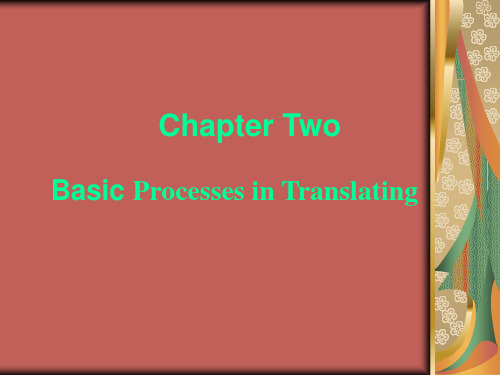
Gaulle) 【译文】他生性乐观, 身材魁梧,贪食贪杯又贪色。 【解析】“huge appetite for...”是“胃口很大”,“特别喜 欢……”的意思,尤其是和“women”搭配一起,就很顺当地 译成了“贪”,“贪”和“food, drink”也能搭配一起。接连 用了三个“贪”,所以,增译“生性”二字也很符合情理。
2. 1 正确理解 (Comprehensive Reading) 理解就是透彻地了解、懂得、掌握原文所表 达的内容和实质,包括词义、句义、段义、 语义,理解不深不透,译文就不忠不顺。 对初学者要阅读三遍:1.粗读全文,掌握全 文大意;2.逐词,逐句,逐段研究,解决疑 难问题。3.通读原文。
理解的诸多方面
例2:Eager to trust but determined to verify, many single women in an age of risky romance are hiring private detectives to check the background of their suitors. (《中国翻译》, N0.5, 1997) 【译文】这年月,就连谈情说爱都有暗礁。许多单 身女子对向自己求婚者既急切地想以心相许,又想 要知道对方是否靠得住,于是就纷纷雇用私人侦探 去查清对方的身世经历。 【解析】这是个“主-系-表”结构的句子,结构简 单但句意深藏词中。“romance”指浪漫的爱情, 可前面加“risky”就给人留了很大的想象空间,这 个年月爱情不是美好的而是充满危险的,再和 “Eager to trust but determined to verify”进行 对比,后面的句子就不难翻译了。
翻译犹如一种好的商品,加上一个动听悦 耳的名字,无疑会锦上添花,魅力无穷。比如 像我们常见的一种饮料“coca-cola”,如译成 “可可饮料” 就显得贫乏无味,译成 “可口可 乐” 顿觉熠熠生辉、可口诱人。 优美的译文必须经过下列翻译过程: 理解 分析 --------总体了解 表达 转换 --------重现原文 审校 润色 点睛出神
2. 1 正确理解 (Comprehensive Reading) 理解就是透彻地了解、懂得、掌握原文所表 达的内容和实质,包括词义、句义、段义、 语义,理解不深不透,译文就不忠不顺。 对初学者要阅读三遍:1.粗读全文,掌握全 文大意;2.逐词,逐句,逐段研究,解决疑 难问题。3.通读原文。
理解的诸多方面
例2:Eager to trust but determined to verify, many single women in an age of risky romance are hiring private detectives to check the background of their suitors. (《中国翻译》, N0.5, 1997) 【译文】这年月,就连谈情说爱都有暗礁。许多单 身女子对向自己求婚者既急切地想以心相许,又想 要知道对方是否靠得住,于是就纷纷雇用私人侦探 去查清对方的身世经历。 【解析】这是个“主-系-表”结构的句子,结构简 单但句意深藏词中。“romance”指浪漫的爱情, 可前面加“risky”就给人留了很大的想象空间,这 个年月爱情不是美好的而是充满危险的,再和 “Eager to trust but determined to verify”进行 对比,后面的句子就不难翻译了。
翻译犹如一种好的商品,加上一个动听悦 耳的名字,无疑会锦上添花,魅力无穷。比如 像我们常见的一种饮料“coca-cola”,如译成 “可可饮料” 就显得贫乏无味,译成 “可口可 乐” 顿觉熠熠生辉、可口诱人。 优美的译文必须经过下列翻译过程: 理解 分析 --------总体了解 表达 转换 --------重现原文 审校 润色 点睛出神
汉英翻译教程_课件_U1
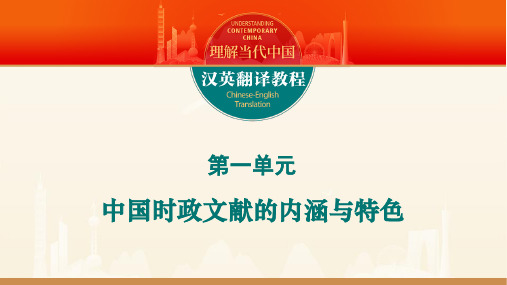
二、中国时政文献的语言特色
用典 典故一般指文章中引用的历史故事、经典文献、诗词歌赋等材料。中国 时政文献常使用典籍、诗词等多种典故,以丰富具体内容的表达效果,突出 具体主题的思想内涵。 例. 法律的生命也在于公平正义,各国和国际司法机构应该确保国际法 平等统一适用,不能搞双重标准,不能“合则用、不合则弃”,真正做到 “无偏无党,王道荡荡”。
第一单元
中国时政文献的内涵与特色
一、中国时政文献的基本内涵
• 集中体现国家政策、方针
• 新概念、新范畴、新表述密集呈现
目
二、中国时政文献的语言特色
录
• 词汇特点
• 句法特点
• 语篇特点
• 修辞特点
一、中国时政文献的基本内涵
1. 集中体现国家政策、方针 作为一种正式文本,中国时政文献是中国共产党和中国政府对外发布中
二、中国时政文献的语言特色
词汇特点 政策术语集中、特殊词汇使用频繁、数字化表达丰富 句法特点
主语省略(隐含)句、连动句、主谓短句(或主谓结构)、 流水句、并列句、长句
语篇特点 语篇衔接、隐性语义连贯 修辞特点 多样化修辞策略、习近平“群众语言”风格
二、中国时政文献的语言特色
4. 修辞特点 4.1 多样化修辞策略 “成语化”四字格、三字格
句法特点
主语省略(隐含)句、连动句、主谓短句(或主谓结构)、 流水句、并列句、长句
语篇特点 语篇衔接、隐性语义连贯 修辞特点 多样化修辞策略、习近平“群众语言”风格
二、中国时政文献的语言特色
1. 词汇特点 1.1 政策术语集中 中国时政文献体现党和国家在政治、经济、文化、外交等领域的方针、
政策,具体领域的专业表述使用集中,内涵丰富,意义重大,如:
新编翻译教程第二章词汇课件
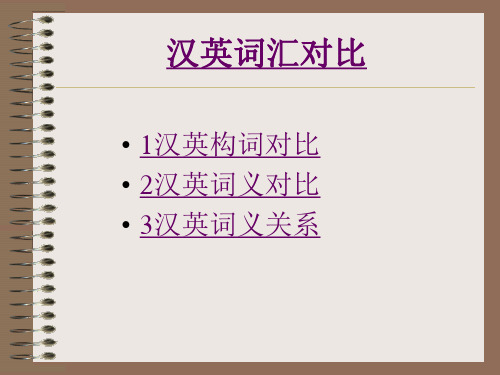
二.词义相异
• 词义相异有两种情况 1.指称意义相符,蕴涵意义相异 (1)松,梅,竹:岁寒三友,不畏严寒,傲然风雪. 但是pine trees, plum blossoms和bamboo不具备 在汉文化的蕴含意义。 (2)羊:吉祥.三羊开泰(Three Rams Bring Bliss)。ram 在英语中除表示 “公羊”外,还 表示“撞击装置”。 2.指称意义和蕴涵意义相异 龙,中华民族的图腾。 dragon常用作贬义,形容凶悍强暴的人。 凤凰,祥瑞。phoenix 在英语中是长生鸟。
重叠法
不同点
转换法,逆构 词法,截短法
合成法
• 由两个或两个以上的词合成一个新词叫合成。 合成词的中间用连字符号,有的直接写。
• 合成名词 • 例:dust+bin—dustbin 垃圾箱 • sun+shine—sunshine 阳光 合成形容词 • man+made—man-made 人造的 • good+looking—good-looking 好看的 合成动词 • safe+guard—safeguard 保卫 • white+wash—whitewash 粉刷 • 合成副词 • off+hand---offhand 草率地 • Over+night---overnight 在夜里
• record/ri’k :d/v记录 record/’rek :d/唱片 • perfect/p ‘fekt/v.使完善 perfect/’p :fekt/adj.完善的 • contest/k n’test/v.比赛 contest/’k ntest/n.比赛
缩略法
• • • • • • • • 汉语构成缩略词: 北京大学 北大 中央电视台 央视 人民代表大会 人大 英语构成缩略词: December Dec. Tuesday Tues. United Nations UN
新编英汉翻译教程第一章 ppt课件
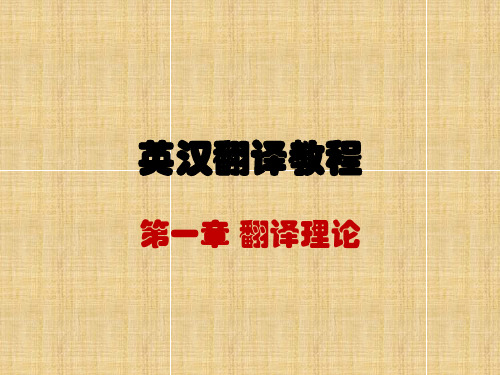
2)Interlingual translation (语际翻译) The translation among different
languages. For example, translation from English to Chinese.
• Section 2 Types of translation
• First of all, a translation should let people know the meaning (or get the information) of the source language.
• However, translation is not a pure linguistic activity. It also involves other non-linguistic elements, especially cultural element. Therefore, some researchers define translation as in line 2, page 3.
• 奈达有关翻译的定义指明,翻译不仅是词 汇意义上的对等,还包括语义、风格和文 体的对等,翻译传达的信息既有表层词汇 信息,也有深层的文化信息。
• Source language to target language
• 源语言(译出语) 目标语(译入语)
• What is the aim of translation?
们是烹鸡专家!
• Questions: what are the criteria of translation? Or, what is a good translation?
• Section 3 criteria of translation • Basic requirements: Faithfulness
languages. For example, translation from English to Chinese.
• Section 2 Types of translation
• First of all, a translation should let people know the meaning (or get the information) of the source language.
• However, translation is not a pure linguistic activity. It also involves other non-linguistic elements, especially cultural element. Therefore, some researchers define translation as in line 2, page 3.
• 奈达有关翻译的定义指明,翻译不仅是词 汇意义上的对等,还包括语义、风格和文 体的对等,翻译传达的信息既有表层词汇 信息,也有深层的文化信息。
• Source language to target language
• 源语言(译出语) 目标语(译入语)
• What is the aim of translation?
们是烹鸡专家!
• Questions: what are the criteria of translation? Or, what is a good translation?
• Section 3 criteria of translation • Basic requirements: Faithfulness
- 1、下载文档前请自行甄别文档内容的完整性,平台不提供额外的编辑、内容补充、找答案等附加服务。
- 2、"仅部分预览"的文档,不可在线预览部分如存在完整性等问题,可反馈申请退款(可完整预览的文档不适用该条件!)。
- 3、如文档侵犯您的权益,请联系客服反馈,我们会尽快为您处理(人工客服工作时间:9:00-18:30)。
c) In any one context a lexeme is likely to have only one meaning unless multiple meanings are in some way indicated by the immediate or broader contexts. d) No two lexemes in a language have exactly the same meanings.
Men: Hey! What are you doing up my roof? Simpleton: When your wife invited me to supper, she said the dinner would be on the house.
“On the house” in English is an idiom which means “free of charge”.
3.1 Lexical context and translation The meaning of the isolated word usually remains indefinite. Context functions as the basic frame of reference to decide the thematic meaning.
Restrictive function is one of the major functions of context and also playing an important part in meaning understanding. I never had much in seeing you. There was no love lost between us at any time, I think. 我向来不大看到你,咱们两人之间大 概什么时候都不曾有过好感。
3 Linguistic context and translation
Linguistic context refers to the relevant text or discourse of which a sentence, a phrase, a word etc. is part or whatever longer text is relevant to same specific inquiry. Hatim and Mason (2001:204) define linguistic context as “the textual environment of a linguistic item”.
Chinese linguist He Ziran postulated that context is defined as “the environmental verbal communication depends on”. It includes: (i) linguistic context: words, phrases and sentences preceding or following a certain utterance;
So writers today should take heart. We could dress like Lady Gaga and hang from a cage at a Yankees game — if any of us looked as good near-naked, that is. 所以今天的作家应该鼓足勇气。 只要我们 中任何人有几分姿色,我们就可以打扮成 嘎嘎夫人那样,在洋基队比赛中将自己挂 在笼子状的裙子里---几近裸体。
3.2 Syntactical Context and translation Syntactical Context serves not only to eliminate syntactical ambiguities, but also to govern interrelations between words in the sentences.
2.2 Restrictive function Restrictive function refers to the influence of context on language application and language study. From the broad sense, this function may influence the whole nature, the human society and the culture. And from the narrow sense, it may influence a sentence, a phrase orБайду номын сангаасeven a word.
This function can be subdivided into three aspects: (i) The restrictive on meaning in an entire scale. (ii) The restrictive on meaning through preceding or furthermore part information of a text. (iii) The restrictive on meaning based on cultural differences.
(ii) social context: the objective environment in which the addresser produces and the addressee interprets an utterance, such as settings for communication, the status of and the relationship between the addresser and addressee, their social and backgrounds; (iii) cognitive environment: any experiences, background knowledge or other which contribute to communication and cognition(何 自然, 1997:210).
再如“Attention” 一在候机厅意指“注意!”, 在练兵场上则指“立正!”。 台湾电视台转播美国电视台宇航员升空的 实况。宇航员:“We are in good shape”. 我们的三围很好。 我们情况良好。
2. Functions of context
2.1 Interpretive function Interpretive function refers to the explanations and illustrations to some language phenomena in language using. It combines the situations that the event happens with the co-conditions of surroundings together and offers us a general expression and the prediction of understanding and then narrows down the choices according to the situation, and then identifies the one that is most suitable.
Chapter 5
Context and Translation
1. Definition of context
In a narrow sense, context refers to the words, phrases and sentences in which a word is used. This is what is known as linguistic context, which may be a paragraph, a whole chapter and even an entire book. And the physical, social and cultural setting, etc. are known as nonlinguistic context.
4.1 Situational context and translation 4.1.1 Spatial context Spatial context refers to the place where the utterance happens. Under most circumstances meaning of utterance has close relationship with specific sites. (1) It’s time to go abroad. Translation (A):该上车了。 Translation (B):该上飞机了。
Nida proposes basic analytical principles of analyzing the meanings of lexemes: a) The correct meaning of a lexeme in any one context is the one that fits the context best. b) Unless otherwise contextually marked, the central or core meaning of a term is to be assumed as correct.
It’s when the publication date looms that we have to roll up our sleeves and tackle the real literary labor. (《作家成名之道》) 搞写作的人都知道,现在写书简直就是 小菜一碟。要到出版日期临近时,我们 才不得不挽起袖子,开始下起真正的文 学功夫来。
